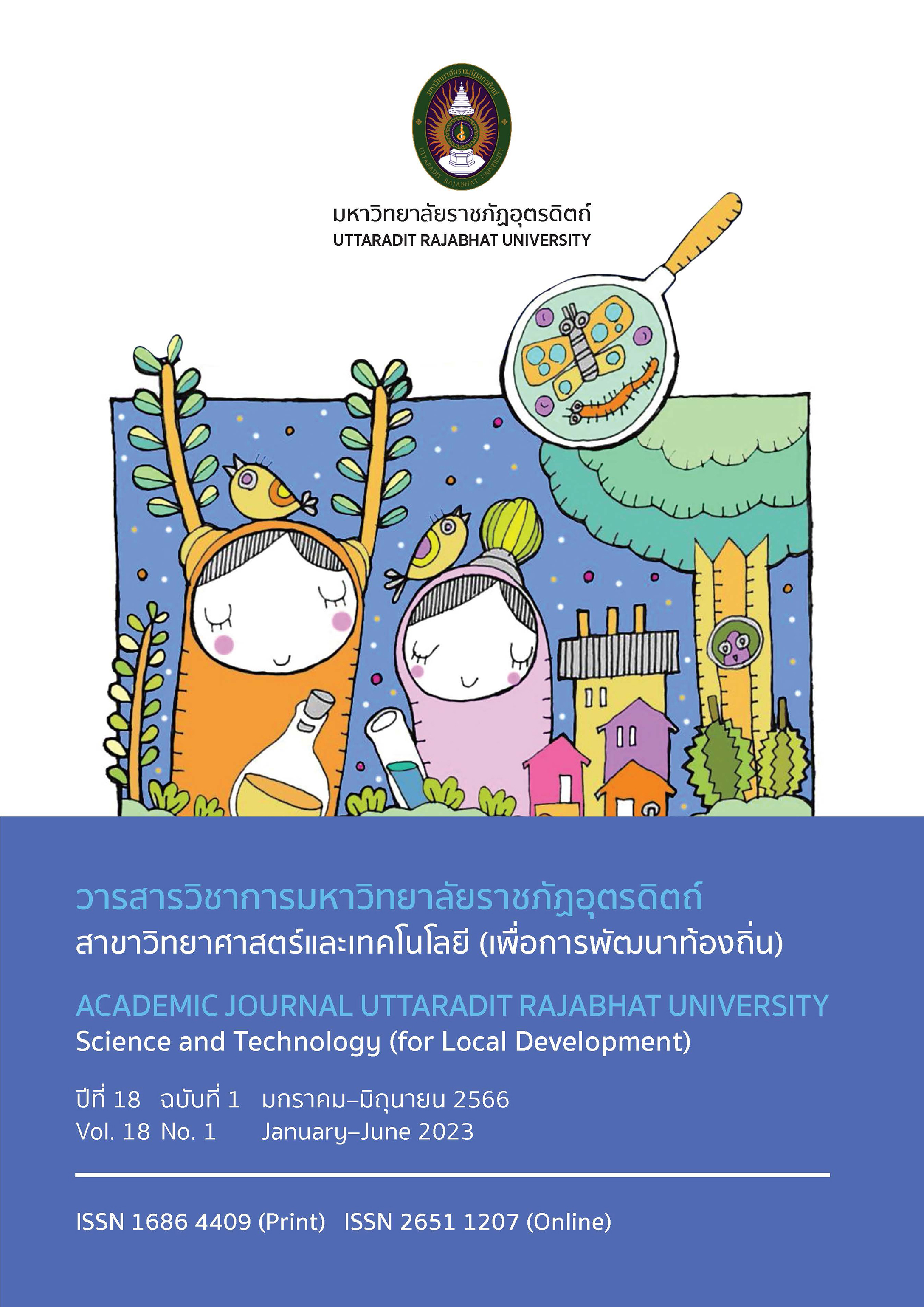การประเมินความปลอดภัยจากการปนเปื้อนและการสะสมทางชีวภาพ ของแคดเมียมในส้มโอในจังหวัดพิจิตร
Main Article Content
บทคัดย่อ
การวิจัยนี้มีวัตถุประสงค์เพื่อวิเคราะห์และประเมินปริมาณการปนเปื้อนแคดเมียมในดินและผลส้มโอ 3 สายพันธุ์ ได้แก่ พันธุ์ขาวแตงกวา พันธุ์ทองดี และพันธุ์ท่าข่อย ในพื้นที่ตำบลโพธิ์ประทับช้าง อำเภอโพธิ์ประทับช้าง จังหวัดพิจิตร รวมถึงประเมินค่าดัชนีมลพิษและประเมินการสะสมทางชีวภาพของแคดเมียมในส้มโอ โดยเก็บตัวอย่างดินและส้มโอในสวนเดียวกันจากการสุ่มแปลงตัวอย่าง จำนวนสายพันธุ์ละ 10 สวน รวมทั้งหมด 30 สวน และเก็บตัวอย่างส้มโอ 2 ผลต่อสวน ปริมาณแคดเมียมในตัวอย่างดินและส้มโอวิเคราะห์โดยใช้เครื่องอะตอมมิกแอปซอบชั่น สเปกโตรโฟโตมิเตอร์ ผลการวิจัย พบว่าการปนเปื้อนแคดเมียมในดินของสวนส้มโอพันธุ์ขาวแตงกวา พันธุ์ท่าข่อย และพันธุ์ทองดี มีค่าเฉลี่ย 1.28±0.25, 0.54±0.15 และ 0.42±0.19 มิลลิกรัมต่อกิโลกรัม ตามลำดับ ซึ่งไม่เกินเกณฑ์มาตรฐานคุณภาพดินของกรมพัฒนาที่ดินที่กำหนดไว้ การปนเปื้อนแคดเมียมในเนื้อส้มโอพันธุ์ขาวแตงกวา พันธุ์ทองดี และพันธุ์ท่าข่อย มีค่าเฉลี่ย 0.40±0.07, 2.32±0.17 และ 2.37±0.34 มิลลิกรัมต่อกิโลกรัม ตามลำดับ ปริมาณแคดเมียมในเนื้อพันธุ์ทองดี และพันธุ์ท่าข่อย เกินค่ามาตรฐานของ The Prevention of Food Adulteration Rules ส่วนการปนเปื้อนแคดเมียมในเปลือกส้มโอมีปริมาณน้อยกว่าส่วนเนื้อ ซึ่งไม่เกินเกณฑ์มาตรฐานที่กำหนดไว้ สำหรับค่าดัชนีมลพิษและการสะสมทางชีวภาพของแคดเมียมในส้มโอพันธุ์ทองดีและพันธุ์ท่าข่อยมีค่าเฉลี่ยมากกว่า 1 มีความเป็นไปได้ว่าส้มโอพันธุ์ทองดีและพันธุ์ท่าข่อยจะมีความสามารถในการดูดซับแคดเมียมสูง ดังนั้นต้องมีความระมัดระวังในการใช้สารเคมีทางการเกษตรที่มีแคดเมียมเป็นองค์ประกอบในกระบวนการปลูก
Downloads
Article Details

อนุญาตภายใต้เงื่อนไข Creative Commons Attribution-NonCommercial-NoDerivatives 4.0 International License.
เอกสารอ้างอิง
กรมพัฒนาที่ดิน. (2564). ดินปนเปื้อน. สืบค้น 1 พฤศจิกายน 2564, จาก https://www.ldd.go.Th/Web_Soil/polluted.htm
กรมวิชาการเกษตร. (2560). การจัดทะเบียนผู้ส่งออก และกฎ ระเบียบ และเงื่อนไขการส่งออกสินค้าเกษตร ออกนอกราชอาณาจักร. นนทบุรี : ชุมนุมสหกรณ์การเกษตรแห่งประเทศไทย จำกัด.
กรมวิชาการเกษตร. (2561). Good Agricultural Practice/GAP. สืบค้น 2 มีนาคม 2565, จาก http://www.foodnetworksolution.com/wiki/word/1637/good-agricultural-practice-gap.
เขมชิต ธนากิจชาญเจริญ, นงนาถ เมฆรังสิมันต์, และสุรชัย ศิลามณีโชติ. (2551). ประโยชน์และความเป็นพิษของโลหะหนักแคดเมียม. สืบค้น 20 ธันวาคม 2564, จาก https://www.dss.go.th/images/st-article/cp_4_2551_Cadmium.pdf
จังหวัดพิจิตร. (2555, 9 พฤศจิกายน). ภูมิประเทศจังหวัดพิจิตร. สืบค้น 2 มีนาคม 2564 จาก http://www.phichit.go.th/phichit/index.php/about/place
ทวีศักดิ์ ชัยเรืองยศ. (2560, 2 พฤษภาคม). ผลิตส้มโอขาวแตงกวาให้ได้คุณภาพ สร้างรายได้ดีหลักแสนถึงหลักล้าน ตลาดนิยมบริโภค ผิวไม่สวยก็ยังขายได้ดีในประเทศ. สืบค้น 28 ธันวาคม 2563, จาก https://www.technologychaoban.com/agricultural-technology/article_17908.
ธีรนันท์ วรรณศิริ. (2561). ประสบการณ์การใช้สารเคมีของเกษตรกรชาวสวนส้มโอจังหวัดนครปฐม. วารสารวิจัยและพัฒนา วไลยอลงกรณ์ในพระบรมราชูปถัมภ์, 13(1), 199-209.
ปิยะดา วชิระวงศกร, เทียมจันทร์ นิลสนธิ, มุกตาภา อ้ายคำ, เกสรา เผือกชาวนา, ธมนวรรณ ฉวยกระโทก, และอรอนงค์ จันทคุณ. (2564). การประเมินความปลอดภัยจากการสะสมแคดเมียมของมะม่วงส่งออกในจังหวัดพิษณุโลก. วารสารพิษวิทยาไทย, 36(1), 1-17.
พรรณิภา แต้มดี และปิยะดา วชิระวงศกร. (2564). การปนเปื้อนโลหะหนักในดินของพื้นที่ผลิตผักเศรษฐกิจในจังหวัดพิษณุโลก. PSRU Journal of Science and Technology, 6(2), 98-108.
เพชรกวินท์ เนื่องสมศรี. (2561, 18 ธันวาคม). อันตรายภายในดิน. สืบค้น 2 มีนาคม 2565, จาก https://www.nsm.or.th/nsm/th/node/6303
ยศเวท สิริจามร, ปรารถนา เผือกวิไล, และณิมนาราห์ อยู่คงแก้ว. (2560). ศักยภาพในการดูดซับและสะสมโลหะหนักของพืชล้มลุกชนิดเด่นบริเวณพื้นที่รอบเหมืองแร่ทองคำ จังหวัดพิจิตร. วารสารวิทยาศาสตร์และเทคโนโลยี, 25(1), 110-123.
วิฑูร ไตรยุทธรงค์. (2563, 5 กรกฎาคม). ส้มโอพันธุ์ท่าข่อยพิจิตรตีตลาดส่งออกกว่า 600 ล้านบาทต่อปี. สืบค้น 11 ธันวาคม 2563, จาก https://www.thethaipress.com/2020/12584/.
ศิริวรรณ จินตา และปิยะดา วชิระวงศกร. (2564). การประเมินปริมาณโลหะหนักที่ปนเปื้อนในผักเศรษฐกิจ: กรณีศึกษาในตำบลบึงพระ อำเภอเมือง จังหวัดพิษณุโลก. PSRU Journal of Science and Technology, 6(1), 28-38.
สำนักงานที่ปรึกษาการเกษตรต่างประเทศ ประจำสหภาพยุโรป. (2563). ข่าวสารด้านการเกษตรสหภาพยุโรป : กฎระเบียบและเงื่อนไขในการส่งออก ผัก/ผลไม้แปรรูปไปยังสหภาพยุโรป. สืบค้น 8 มีนาคม 2564, จาก https://appdb.tisi.go.th/tis_devs/regulate/eu/pdf/Import_Regulation_EU.pdf
สำนักงานเศรษฐกิจการเกษตร. (2564). สถิติการส่งออก (Export). สืบค้น 8 มีนาคม 2564, จาก http://impexp.oae.go.th/service/export.php?S_YEAR=2562&E_YEAR=2563&PRODUCT_GROUP=5252&PRODUCT_ID=5032&wf_search=&WF_SEARCH=Y.
สิทธิชัย อินทร์ปนาม. (2558). รูปของโลหะหนักตามความเข้มข้นของโลหะหนักในดินที่สกัดด้วยวิธี sequential extraction (รายงานการวิจัย). มหาวิทยาลัยนเรศวร. https://www.agi.nu.ac.th/nred/Document/is-PDF/2558/nre_2558_027_Abstract.pdf
Agency for Toxic Substances and Disease Registry. (1990). Toxicological profile for lead. U.S. Department of Health and Human Services.
Assunção, A. G. L., Bookum, W. M., Nelissen, H. J. M., Vooijs, R., Schat, H., & Ernst, W. H. O. (2003). Differential metal-specific tolerance and accumulation patterns among Thlaspi caerulescens populations originating from different soil types. New Phytologist, 159(2), 411-419. https://doi.org/10.1046/j.1469-8137.2003.00819.x
Chukwuma, Chrysanthus, Sr. (1994). Evaluating baseline data for lead (Pb) and cadmium (Cd) in rice, yam, cassava, and guinea grass from cultivated soils in Nigeria. Toxicological & Environmental Chemistry, 45(1-2), 45-56. https://doi.org/10.1080/02772249409358069
Czech, A., Malik, A., Sosnowska, B., & Domaradzki, P. (2021). Bioactive substances, heavy metals, and antioxidant activity in whole fruit, peel, and pulp of citrus fruits. International Journal of Food Science, 2021. https://doi.org/10.1155/2021/6662259
Dinh, V.-P., Xuan, T. D., Hung, N. Q., Luu, T.-T., Do, T.-T.-T., Nguyen, T. D., Nguyen, V.-D., Anh, T. T. K., & Tran, N. Q. (2020). Primary biosorption mechanism of lead (II) and cadmium (II) cations from aqueous solution by pomelo (Citrus maxima) fruit peels. Environmental Science and Pollution Research, 28(45), 63504–63515. https://doi.org/10.1007/s11356-020-10176-6
Fitz, W. J. & Wenzel, W. W. (2002). Arsenic transformations in the soil–rhizosphere–plant system: fundamentals and potential application to phytoremediation. Journal of Biotechnology, 99(3), 259-278. https://doi.org/10.1016/S0168-1656(02)00218-3
Jamali, M. K., Kazi, T. G., & Arian, M. B. (2007). Determination of pollution indices. Environmental pollution handbook (pp. 209-218). China.
Liang, J., Chen, C., Song, X., Han, Y., & Liang, Z. (2011). Assessment of heavy metal pollution in soil and plants from Dunhua sewage irrigation area. International Journal of Electrochemical Science, 6(1), 5314-5324.
Lim, L. B. L., Priyantha, N., Lu, Y. C., & Zaidi, N. A. H. M. (2019). Adsorption of heavy metal lead using Citrus Grandis (pomelo) leaves as low-cost adsorbent. Desalination and Water Treatment, 166, 44-52. https://doi.org/10.5004/dwt.2019.24620
Lugon-Moulin, N., Ryan, L., Donini, P., & Rossi, L. (2006). Cadmium content of phosphate fertilizers used for tobacco production. Agronomy for Sustainable Development, 26, 151-155. https://doi.org/10.1051/agro:2006010
Rahimzadeh, M. & Rastegar, S. (2017). Heavy metals residue in cultivated mango samples from Iran. Journal of Food Quality and Hazards Control, 4, 29-31.
Rezvani, M. & Zaefarian, F. (2011). Bioaccumulation and translocation factors of cadmium and lead in Aeluropus littoralis. Australian Journal of Agricultural Engineering, 2(4), 114-119.
The Prevention of Food Adulteration Act & Rules. (2004). Retrieved on March 6, 2022, from https://fssai.gov.in/upload/uploadfiles/files/pfa-acts-and-rules.pdf
U.S.-Environmental Protection Agency. (1999). Integrated Risk Information System (IRIS) on Cadmium. Office of Research and Development National Center for Environmental Assessment.


